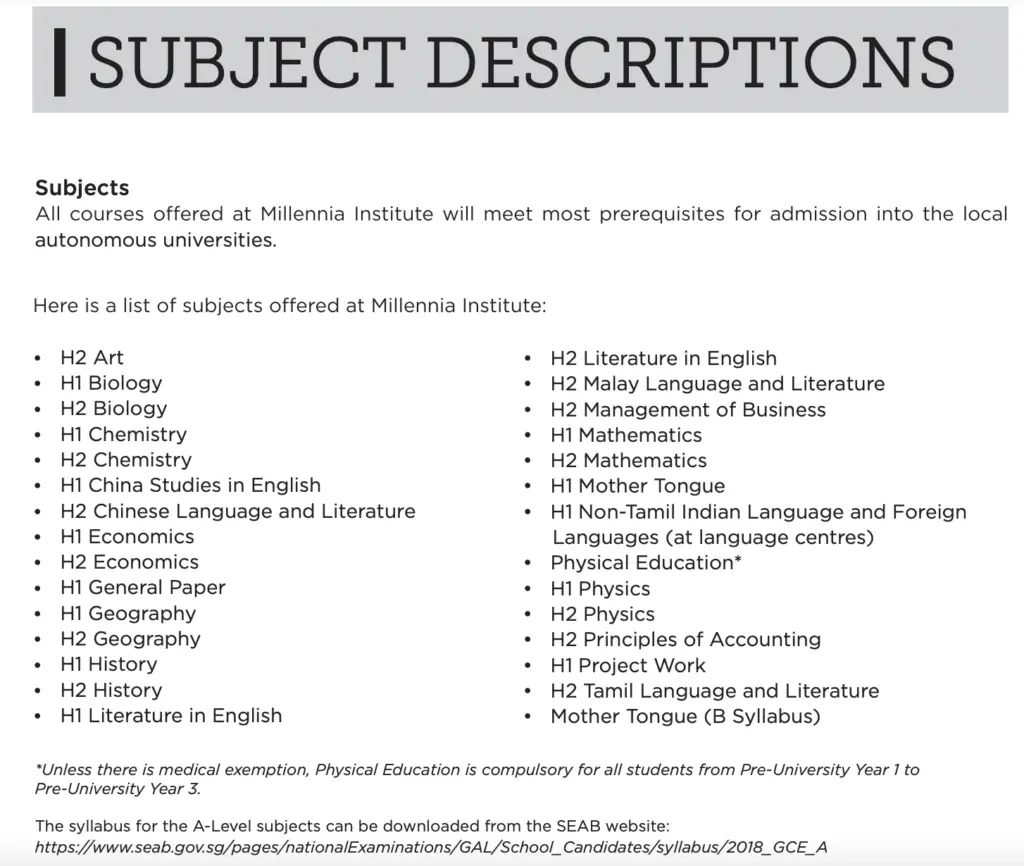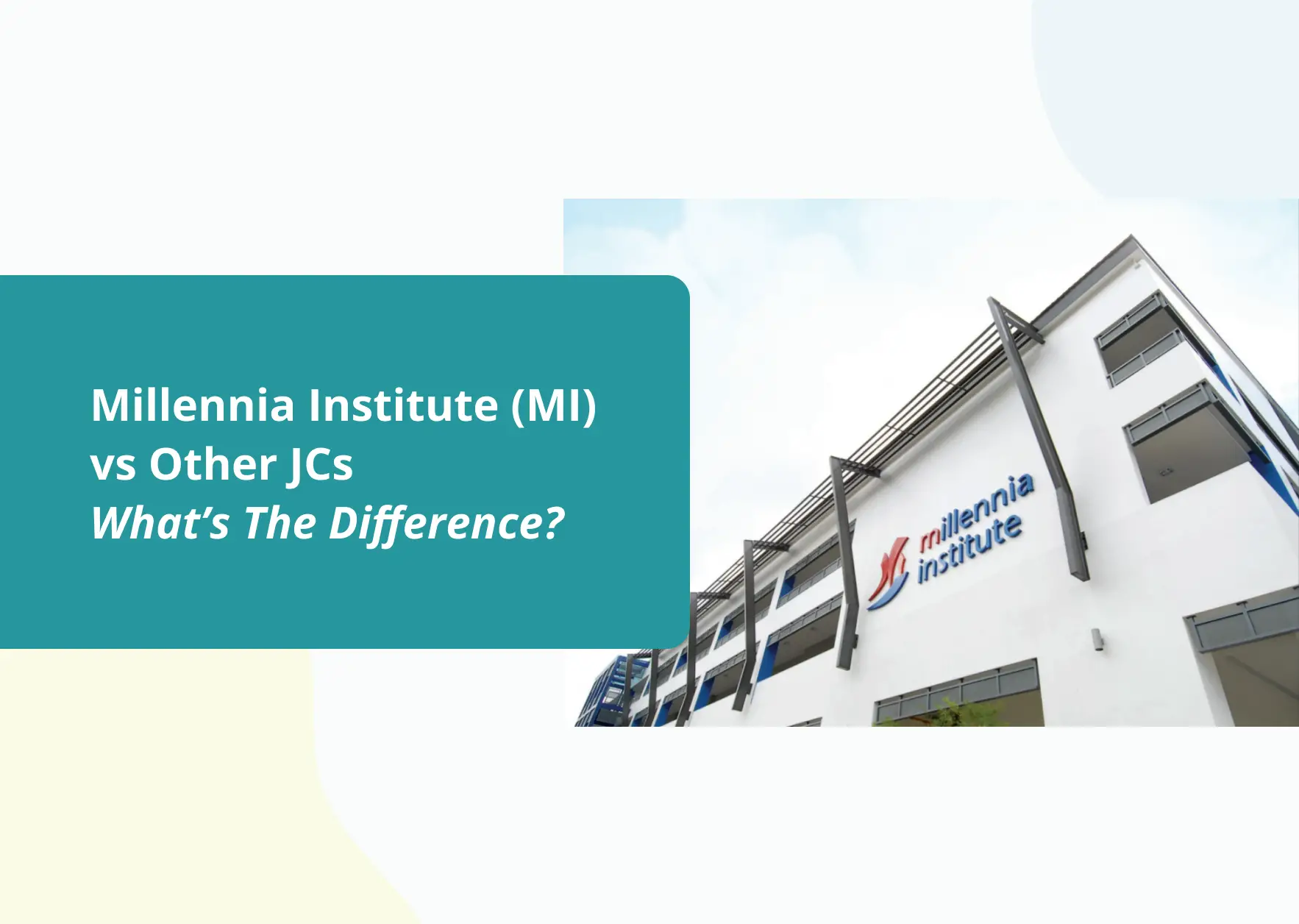If you’ve just received your O Level results, you may be thinking of applying for a Junior College (JC). However, you may have noticed that you are also able to apply for Millennia Institute (MI), which also allows you to take A-Levels as well.
What’s the difference between a JC and MI, and which should you choose?
Here’s what you need to know:
Admission criteria
When you are applying to JCs via the Joint Admissions Exercise (JAE), your L1R5 score will be used to determine your eligibility to apply for a certain JC.
Your L1R5 score has to be ≤ 20 to apply for a Junior College.
You can either apply to the Science or Arts streams at different JCs like NYJC, NJC and ACJC. The L1R5 cutoff for Science may be lower compared to the cutoff for the Arts stream, depending on the intake.
Meanwhile, MI uses the L1R4 score to determine your eligibility to apply for a place in their institute. The scoring for L1R4 is slightly different from L1R5:
| L1 | English or Higher Mother Tongue Language (MTL) |
| R1 and R2 | Any 2 of: – Humanities – Higher Art / Music – Mathematics – Science – Malay / Chinese (Special Programme) – Bahasa Indonesia |
| R3 and R4 | Any 2 GCE O-Level subjects (except Religious Knowledge) |
Your L1R4 has to be ≤ 20 to apply for MI, which is ‘less strict’ compared to the JC’s L1R5.
Apart from the L1R4 score, you are required to meet certain subject requirements:

Length of study
For most JCs, the length of study will be 2 years, before you take your A-Levels at the end of JC2. Both the Mother Tongue Language (MTL) and Project Work will be examined at the end of JC1, while GP and other subjects will be examined at the end of JC2.
For MI, you will be taking a 3-year course, from Pre-University (PU) 1 to PU3.
The times where you are examined for your A-Level subjects will be different from a JC student:
| MI | Other JCs | |
|---|---|---|
| JC1 / PU1 | None | PW and MTL |
| JC2 / PU2 | PW, H1 subject and H1 MTL | GP and remaining A Level subjects |
| PU3 | H2 subjects and GP | NA |
As such, you are given more time to complete all of your A-Level requirements compared to doing A-Levels at a JC.
Subjects offered
In most JCs, you will be offered H1, H2 and H3 subjects.
These H3 subjects can range from:
- MOE H3 subjects
- External H3 subjects by partner institutions.
For MI, it was only mentioned that they offered both H1 and H2 subjects.

As such, it may not be possible for you to take any H3 subjects at MI.
You may also want to note that MI does not offer Knowledge and Inquiry, which is an H2 subject that replaces GP.
One of MI’s key differentiating factors is that you are able to take 2 A-Level subjects that are not offered at other JCs:
If you have an interest in doing a business degree in university, you may want to consider taking up these subjects which are only offered in MI.
In a Reddit post, u/irawantsfood mentioned that the content of MOB is quite similar to what is being taught in polytechnics.

Subject combinations
In most JCs, it is possible for you to take 4 H2 subjects, provided that you meet certain criteria to do so.
However, MI only allows you to do a 3 H2 and 1 H1 subject combination.

For most JCs, you are able to do either an Arts or Science stream, where you will take 3 of the same subjects from a similar category and 1 contrasting subject.
There may be some JCs that may offer you a hybrid stream, where you can take 2 subjects each from Arts and Science.
Meanwhile, due to the 2 extra subjects that MI offers (MOB and PAA), MI allows you to take a Commerce stream, where you can take a few combinations that include Economics, MOB and PAA.

For the Arts and Science combinations, you are able to take MOB or PAA as one of the 3 H2 subjects too.
This may give you slightly more flexibility in terms of the subject combination that you wish to take. With the MOB and PAA subjects, it will help to give you more exposure to skills that may be useful for a business degree in the future.
You may want to note that none of these JCs will offer triple science as one of their subject combinations.
Verdict
Here is a comparison of the differences between these 2 institutes:
| MI | Other JCs | |
|---|---|---|
| Score used | L1R4 ≤ 20 | L1R5 ≤ 20 |
| Length of study | 3 years | 2 years |
| JC1 / PU1 A-Level Exams | None | PW and MTL |
| JC2 / PU2 A-Level Exams | PW, H1 subject and H1 MTL | GP and remaining A-Level subjects |
| PU3 A-Level Exams | H2 subjects and GP | NA |
| Level of subjects | H1 and H2 | H1, H2 and H3 |
| Differentiating subjects offered | MOB and PAA (not found in JCs) | – |
| Subject combinations | 3 H2 + 1 H1 only | 3 H2 + 1 H1 OR 4 H2 |
| Types of subject combinations | Arts, Science and Commerce | Arts, Science and Hybrid (not all) |
Overall, MI provides some unique offerings compared to JCs, which include:
- Use of L1R4 score for admission (vs L1R5)
- 3-year A-Level programme (vs 2-years for other JCs)
- MOB and PAA subjects (not found in other JCs)
- The possibility to do a Commerce stream (in addition to Arts and Science streams)
Since MI offers business-related subjects (MOB and PAA), you can consider going to MI and taking these subjects as an alternative to going to a polytechnic.
If you feel that you may not be able to cope with the rigour of a 2-year programme in other JCs, MI may be better to help you to pace yourself.
However, there is still a possibility that you may retain if you do not meet the promotion criteria!
If you enjoyed this content, do follow us on Telegram!

Want to earn some money while sharing your experiences in Singapore? We’re always looking for writers and you can join our team here!
